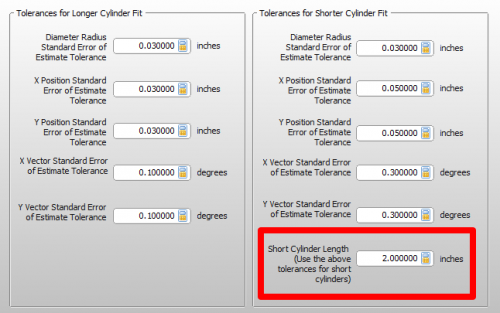Difference between revisions of "VTube-LASER Cylinder Fit Tolerances"
(→Recommended Aerospace-Grade Cylinder Fit Tolerances) |
(→Why Are There Separate Values for Shorter Straights?) |
||
| Line 104: | Line 104: | ||
<tr valign=top> | <tr valign=top> | ||
<td width=300> | <td width=300> | ||
| − | + | Math engines cannot calculate short straights as accurately as long straights. This has to do with the nature of cylinder math. It is common issue with all measuring centers. Because of this, we know that VTube needs to be more patient with when fitting a cylinder centerline when the straight length is below a certain value.<br><br> | |
In the default setup for VTube-LASER, a straight is considered "short" when it is 2 inches (50.8 millimeters) or shorter. | In the default setup for VTube-LASER, a straight is considered "short" when it is 2 inches (50.8 millimeters) or shorter. | ||
</td> | </td> | ||
Revision as of 18:06, 20 February 2017
|
"How Well Does Centerline Fit the Cylinder Surface Points?"
|
VTube-LASER uses surface points scanned with laser or measured with ball probes to calculate tube centerlines. |
The Cylinder Fit Data Window Reports How Well the Centerline Fits the Surface Data
|
After calculating a cylinder centerline from surface points, VTube-LASER reports how well the centerline FITS the surface points of the cylinder. These values are shown in the Cylinder Fit Data window.
These estimate values are calculated using statistical math. The values are standard deviation x 2, which means that we have 95% assurance that the these values are the maximum deviation. |
Wobble Deviation - The highest of the X or Y values
|
To simplify visualizing the X and Y Position deviation, we say that the highest of the X and Y values is the "wobble deviation". The wobble deviation in the example on the right is 0.21 inches - because it is the higher of the two values. |
The Default Cylinder Fit Tolerances
|
To allow VTube-LASER to warn for poor cylinder measurements, it stores tolerances for the allowed deviations during cylinder fit. The default values shown here often the installed default values in the Measure 1 tab of the System Options menu. |
Recommended Aerospace-Grade Cylinder Fit Tolerances
|
Aerospace-grade materials are often very precise compared to other applications. For aerospace applications, we strongly recommend that you use the tighter tolerances shown here. |
Why Are There Separate Values for Shorter Straights?
|
Math engines cannot calculate short straights as accurately as long straights. This has to do with the nature of cylinder math. It is common issue with all measuring centers. Because of this, we know that VTube needs to be more patient with when fitting a cylinder centerline when the straight length is below a certain value. |
How to Test for Your Ideal Cylinder Fit Tolerances
|
You can adjust the tolerances in System Options to better fit your application and increase the assurance that your centerline is a good fit to the surface data. Test for ideal cylinder fit tolerance settings by measuring tubes and watching the tolerance values in the Cylinder Fit window. As an example, if you never see deviations over 0.014" (like shown on the right), you could set the tolerance value to 0.030" (which is double the max observed). If a cylinder fit deviation exceeds double the norm, then you can safely assume that there is a problem in the measurement, and you should be warned. |
Other Pages
- Back to VTube-LASER
- Back to VTube-STEP








